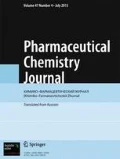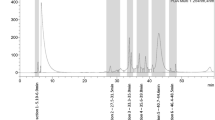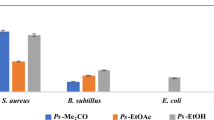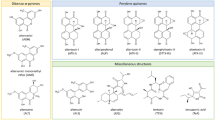Fusarium equiseti, an endophytic fungus isolated from the marine alga Padina pavonica, displayed in vitro potent cytotoxicity and selectivity against liver cancer (HEP-G2) cells. This endophyte was therefore submitted to large-scale liquid fermentation to isolate 11 bioactive constituents. The cytotoxic effect of the extract against in vivo hepatocellular carcinoma (HCC) was evaluated in rats with HCC induced by single intraperitoneal injection of N-nitrosodiethylamine (NDEA) followed by subcutaneous injections of CCl4. After the injection of carcinogen, the fungal extract was orally administered in 25, 50 and 100 mg/kg doses once a day for 10 weeks. The high levels of liver injury and liver cancer markers after NDEA administration were significantly decreased by this treatment with the total fungal metabolites. Histological observations of the liver tissues of rats treated with NDEA and fungal extract co-administered at 100 mg/kg are correlated with the biochemical observations. These findings confirm that F. equiseti total metabolites could restore the activity of hepatic marker enzymes of NDEA-induced hepatocarcinogenesis in rats.



Similar content being viewed by others
References
F. X. Bosch, J. Ribes, R. Cleries, et al., Clin. Liver Dis., 9(2), 191 – 211 (2005).
V. Sivaramakrishnan, P. M. Shilpa, V. P. Kumar, et al., Chem. Biol. Interact., 171(1), 79 – 88 (2008).
J. G. Macia-Vicente, H. B. Jansson, S. K. Abdullah, et al., FEMS Microbiol. Ecol., 64(1), 90–105 (2008).
X. Weiping, C. J. Mirocha, and Y. Wen., J. Nat. Prod., 54(4), 1165 – 1167 (1991).
D. Dréau, M. Foster, M. Hogg, et al., Anticancer Drugs, 18(8), 897 – 904 (2007).
G. G. Kuiper, B. Carlsson, K. Grandien, et al., Endocrinology, 138(3), 863 – 870 (1997).
U. W. Hawas, R. Al-Farawati, L. T. Abou El-Kassem, et al., Mar. Drugs, 14(10), E190 (2016).
S. Sundaresan and P. Subramanian, Pol. J. Pharmacol., 55(1), 37 – 42 (2003).
G. Ramakrishnan, H. B. Raghavendran, R. Vinodhkumar, et al., Chem. Biol. Interact., 161(2), 104 – 114 (2006).
S. Reitman and S. A. Frankel, Am. J. Clin. Pathol., 28, 56 – 63 (1957).
E. J. King and A. R. Armstrong, Can. Med. Assoc. J., 311, 152–156 (1934).
W. G. Dangerfield and R. Finlayson, J. Clin. Pathol., 6(3), 173 – 177 (1953).
S. Sell and F. F. Beckar, Natl. Cancer Inst., 60(1), 19 – 26 (1978).
G. M. Macnab, J. M. Urbanowicz, and M. C. Kew, Brit. J. Cancer, 38(1), 51–54 (1978).
R. B. Drury and E. A. Wallington, Carleton’s Histology Technique, 5th edn., Oxford University Press, Oxford (1980).
N. M. M. U. Khan and M. S. Hossain, J. Pharmacogn. Phytochem., 4(2), 5 – 7 (2015).
S. Kiyoto, Y. Kawai, T. Kawakita, et al., J. Antibiot., 39(6), 762 – 772 (1968).
R. A. Cacho, Y. H. Chooi, H. Zhou, et al., ACS. Chem. Biol., 8(10), 2322 – 2330 (2013).
F. Caesar, K. K. Jansson, and E. E. Mutschler, Pharm. Acta. Helv., 44(11), 676 – 690 (1969).
H. Shigemori, M. Tenma, K. Shimazaki, et al., J. Nat. Prod., 61(5), 696–698 (1998).
C. J. Barrow and H. H. Sun, J. Nat. Prod., 57(4), 471–476 (1994).
W. Rungprom, E. R. O. Siwu, L. K. Lambert, et al., Tetrahedron, 64(4), 3147 – 3152 (2008).
F. Valeriote, C. K. Grieshaber, J. Media, et al., J. Exp. Therap. Oncol., 2(4), 228 – 236 (2002).
L. Verna, J. Whysner, and G. M. Williams, Pharmacol. Ther., 71(1 – 2), 57 – 81 (1996).
G. M. Rao, C. V. Rao, P. Pushpangadan, et al., J. Ethnopharmacol., 103(3), 484 – 490 (2006).
C. R. Wolf, W. G. Harrelson, W. M. Nastainczyk, et al., Mol. Pharmacol., 18(3), 553 – 558 (1980).
M. Maeda, S. Tozuka, M. Kanayama, et al., Dig. Dis. Sci., 33(12), 1629 – 1631(1988).
M. Munekata and G. Tamura, Agric. Biol. Chem., 45(11), 2613 – 2618 (1981).
R. Zhu, R. Zheng, Y. Deng, et al., Phytomedicine, 21(3), 372 – 378 (2014).
Q. P. Wu, Y. Z. Xie, Z. Deng, et al., PLoS One, 7(8), e44579 (2012).
Acknowledgments
The authors thank Prof. Fred Valeriote, Henry Ford Cancer Health System, Detroit, Michigan, USA, for the tests with cell lines. This work was supported by a Basic and Applied Research Grant from the Egyptian Science and Technological Development Fund (STDF, Grant No. 990).
Author information
Authors and Affiliations
Corresponding author
Rights and permissions
About this article
Cite this article
Hawas, U.W., Farrag, A.R.H., Ahmed, E.F. et al. Cytotoxic Effect of Fusarium Equiseti Fungus Metabolites Against N-Nitrosodiethylamine- and CCL4-Induced Hepatocarcinogenesis in Rats. Pharm Chem J 52, 326–333 (2018). https://doi.org/10.1007/s11094-018-1816-3
Received:
Published:
Issue Date:
DOI: https://doi.org/10.1007/s11094-018-1816-3




